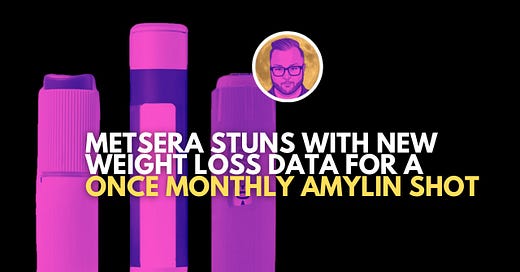Is This the First Real Threat to Lilly and Novo? Metsera’s Stunning New Data for Once Monthly Amylin Agonist
The race to develop more convenient, more effective, and better tolerated weight-loss medicines just got another jolt this morning, courtesy of Metsera.
The New York-based startup, which is backed by $500 million in venture capital, announced new topline data from its Phase 1 trial of MET-233i, an ultra-long-acting amylin analog designed to pair with its lead GLP-1 candidate, MET-097i. And the results are raising eyebrows.
In the study, MET-233i delivered up to 8.4 percent placebo-subtracted weight loss by Day 36, with some individuals seeing over 10 percent. More importantly, the drug showed an observed half-life of 19 days, making it compatible with once-monthly dosing. Even at this early stage, these results position MET-233i as potentially best-in-class among amylin agonists and set the stage for the first monthly GLP-1 plus amylin combination shot.
If you have been following Metsera’s progress, this is a significant milestone. Back in January, the company was already making waves with MET-097i, its once-monthly GLP-1 receptor agonist. Early trial data showed a 7.5 percent body weight reduction by Day 36, later updated to an 11 percent reduction after 12 weeks. That brought MET-097i closer to the efficacy range of Novo Nordisk’s semaglutide and Lilly’s tirzepatide, both dominant players in the market.
Now, with MET-233i coming online, Metsera is stacking two assets that could offer patients a compelling convenience advantage: one monthly shot, two proven mechanisms. The new data also confirm that MET-233i’s exposure profile matches that of MET-097i, meaning the two drugs can be co-formulated as a true combination product.
Safety remains a bright spot. According to today’s release, there were no severe or serious adverse events. Gastrointestinal side effects were mild, dose dependent, and mostly limited to the first week of dosing, suggesting patients may tolerate this combination well.
Of course, this space moves fast, and the bar continues to rise. Tirzepatide is now hitting weight loss of 20 percent or more in some patients. Even Wegovy, already a global blockbuster, is seeing new combinations coming up behind it, including GLP-1 plus GIP or GLP-1 plus amylin approaches.
Metsera knows it cannot win on convenience alone. It will need to demonstrate efficacy that can rival or exceed today’s leaders. Still, the early numbers are promising, especially when you consider the lack of titration and the patient-friendly monthly schedule.
The company is moving quickly. A longer monotherapy trial of MET-233i is already underway, with topline data expected late this year. A twelve-week co-administration trial of MET-233i and MET-097i is also in progress, with results expected by late 2025 or early 2026. On deck is also MET-034i, Metsera’s ultra-long acting GIP receptor agonist, which will eventually be combined with MET-097i as well.
If all of this sounds familiar, it should. This is the multi-pronged strategy Metsera hinted at months ago when it first unveiled its pipeline. In addition to injectables, the company is also developing an oral GLP-1 candidate through its MOMENTUM platform, aiming to enter the competitive oral peptide market as well.
The big picture here is clear. Metsera is going for a portfolio play, trying to cover both injectable and oral markets with differentiated assets that could stand out based on convenience, tolerability, and adherence. Whether they can reach the lofty efficacy benchmarks now expected in this space is still the key unknown.
For patients, though, the potential is easy to see. A monthly GLP-1 and amylin combo that delivers strong weight loss with minimal side effects would be a game changer. Not everyone tolerates weekly shots well, and many patients struggle with complex titration schedules. Metsera’s simplified approach could appeal to those seeking an easier path.
It is also worth watching how larger players respond. Companies like Lilly and Novo have already signaled their own interest in GLP-1 plus amylin combos. If Metsera’s data continue to look strong, the startup could find itself a very attractive acquisition target.
For now, it is one to keep on the radar. The company will be hosting an investor call later today to discuss the new MET-233i data in more detail. I will be listening closely to see what they say about next steps and how quickly they think this monthly combination could move into later stage trials.
Stay tuned to On The Pen for more updates on Metsera and all the fast-moving developments in obesity and GLP-1 medicine.






My guess: either L or N will acquire the company. The result will be prices will remain sky high because they will have eliminated the competition. Big Pharma is cutthroat and patients’ health is a very minor consideration.
Dave,
Thank you for this news!
I hope you are feeling better. As I said before, you are my go to guy! You are loved, my friend.
This makes me so happy!
I am a person who lost 40 pounds on compounded GLP one after a horrible bout with menopause. I feel like myself again thanks to the medicine. All these pharmaceutical companies care about this money. They do not care about the people. I hope Novo and Lily are left in the dust.
Have a great week! Thanks for all you do!